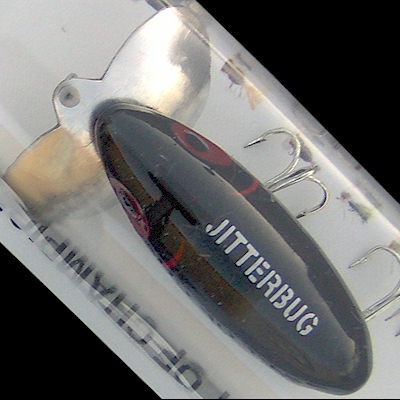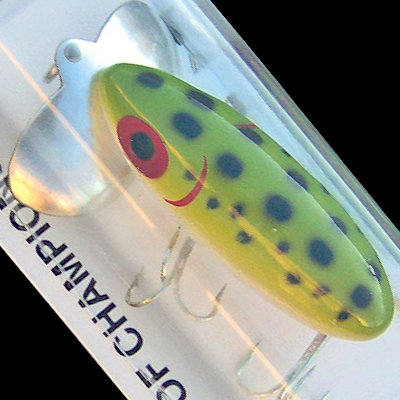Arbogast Jitterbug ~ Topwater Surface Crawler
| Name | Model | Size | Weight | Depth | Type |
| Arbogast Jitterbug | G600 | 2-1/2" (63.5mm) | 3/8 oz (9.7g) | Topwater | Crawler |
Everyone loves to Jitterbug! The Arbogast Jitterbug has been around for over fifty years, and it is still going strong. Ask any night time bass angler if they carry a Jitterbug, and chances are you will hear that they do. Ask them what color they use, and you will no doubt hear that it is black. Yes indeed! Black Jitterbugs produce plenty of night bass. A Jitterbug is so easy to use, and fun too. In short, it is a winner - for night expert or beginner!
Basic Anatomy. It is an oddball kind of lure because of the oversized metal wobbleplate screwed into its nose.
Best on Spinning Gear. The size for sale here - G600 - is 2-1/2 inches long, weighing 3/8 oz. It is a smallish size best for small streams, ponds and small waters. This size does not come with heavy hooks, so medium weight spinning provides a cushion for fighting fish on the light treble hooks.
Cast it to the outside edges of cover like fallen trees. Cast it parallel to the open water in front of long, straight reed berms and along the edges of dense weed beds. You must work the outside edges of cover, because you cannot easily use it by casting right into thick cover or grass at night, and you will get caught up far too often casting it directly into heavy wood cover. So you need to skirt the edges of cover with the Jitterbug at night.
What could be simpler? Just reel in straight and steady in order to get the best fish-enticing action out of a Jitterbug. If you are a beginning night fisherman, it's hard to go wrong here as long as you don't go too fast or too slow - and don't try to get too fancy. I always fish them by fine-tuning the retrieve speed somewhere between a slow to moderate pace that generates the best gurgling sound from the wobbleplate. The right gurgling sound makes bass go off on it. You have to concentrate your hearing on the lure and the noise it makes as you retrieve it. Listen for the lure to make the most life-like sound possible. It's hard to describe, but you will recognize it when you hear it - and bass will also let you know they recognize it by blasting your Jitterbug out of the water at the correct retrieve. Some nights you have to go a little slower or a little faster, depending on wind and water surface conditions. So, always listen and use your ear to fine-tune into that highly desirable life-imitating sound made by the wobbleplate.
Don't Blast Back. This isn't a gun fight. If a bass blasts you and misses, what will you accomplish by blasting back and also missing with a hook-setting effort? You'll accomplish nothing except blow your chances, so please don't do it. Just sharpen your hooks first. The ones that come on a Jitterbug aren't the sharpest in the world. Now when a bass blows up on you, just keep reeling steadily as if nothing ever happened. If she's got you, she isn't going to let go too quickly. Just wait until you feel the weight of the fish on the line. You don't need to be in any kind of rush here. You have a couple of seconds to play with here. If she is on, set the hook. If she missed completely, just continue reeling as if absolutely nothing happened and she'll come back to blast you again!
Advanced Line Control. This paragraph describes an advanced topic - talking about line control for topwater lures. It will help semi-experienced anglers more than beginners, but please read on and try to follow even if you are a beginner. In the case of a Jitterbug, you ideally want all the line between the rod tip and the lure tie to be out of the water, swinging back and forth in the air in response to the lure's movement. There should be a little belly and slackness in the first ten feet of line closest to the lure. If you keep too much tension in the line, you will prevent this "slack zone" from appearing, and if you let too much looseness in the line, the belly will sag or appear mid-distance between the rod and the lure, therefore too far from the lure for the belly to really swing and have a positive influence on the lure action. But if you are doing it right, with the line's slack zone close to the lure, then you will see the line oscillating back and forth like crazy, throwing a rhythmical pendulum arc in the air as the lure action moves the line. If you keep the retrieve pace steady with no variation in line tension, the Jitterbug action will achieve, shall I say, a kind of equilibrium point where the lure is wobbling freely in perfect harmony with the side-to-side action in the line. At that point, your Jitterbug is really moving freely, and you are generating the best, most life-like action you can get out of it. Now fine tune the pace with your ear to get the most life-like gurgling noise out of it. Practice makes perfect here!
That's all you need to know. There isn't much more to it. Really. Now go out and give those night bass the jitters!


Arbogast G600 Jitterbug~ Topwater ~ Black


Arbogast G600 Jitterbug~ Topwater ~ Frog / White Belly
For pricing and current availability, please visit http://www.BassdozerStore.com.
Thank you for your business. May your next fishing trip be your best ever!
Regards,
Russ
